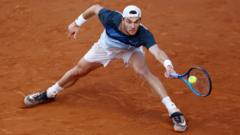Clay-court tennis requires specific attributes for players to thrive, particularly evident as the 2025 French Open approaches. Jack Draper, who recently showcased his potential by reaching the Madrid Open final, enters the tournament as Britain's fifth seed. Historically, clay is not a surface where British players have excelled, with Andy Murray being the last to make a significant impact in the finals back in 2016, while Sue Barker was the last to win it in 1976.
As the French Open nears, discussions swirl around what makes a successful clay-court player. Unlike grass, clay allows for longer rallies and demanding footwork, requiring extraordinary fitness levels. Iga Swiatek, a four-time French Open champion, exemplifies this with her impressive court coverage and quick recovery, vital for executing her powerful forehand shots.
Draper's own journey on clay has seen remarkable improvement; after a challenging start that included injuries, he revamped his training team to enhance his fitness. Collaborating with former members of Murray's crew, Draper has shown resilience on the clay courts, powering through a challenging season and demonstrating his grit in matches.
Moreover, the ability to generate spin is crucial on clay. Rafael Nadal's legendary forehand is iconic for its generation of heavy topspin that propels the ball high and deep, disrupting opponents' rhythm. Former champion Michael Chang noted Nadal's skill in manipulating angles, creating openings for easy shots by forcing rivals into awkward positions.
British players, such as Draper, Emma Raducanu, and Jacob Fearnley, have had a promising clay-court swing leading up to the French Open, showing newfound competitiveness. Practicing sliding techniques has been integral, as sliding into shots enables aggressive returns even from defensive postures. Heather Watson emphasizes the importance of correct sliding mechanics to prevent injury.
The current state of clay-court facilities in Britain presents challenges, with only about 5% of the nation’s courts being clay compared to around 60% in clay-dominant countries like Spain. This disparity potentially affects younger players' experiences and training opportunities. Many British players, including Draper, acquired their skills abroad, following in Murray's footsteps of gaining early exposure to clay tournaments.
As the French Open approaches, the spotlight remains on players like Draper, whose dedication and training could signal a new era for British success on clay. Their experiences underline the blend of fitness, technique, and early training crucial for excelling on this demanding surface.
As the French Open nears, discussions swirl around what makes a successful clay-court player. Unlike grass, clay allows for longer rallies and demanding footwork, requiring extraordinary fitness levels. Iga Swiatek, a four-time French Open champion, exemplifies this with her impressive court coverage and quick recovery, vital for executing her powerful forehand shots.
Draper's own journey on clay has seen remarkable improvement; after a challenging start that included injuries, he revamped his training team to enhance his fitness. Collaborating with former members of Murray's crew, Draper has shown resilience on the clay courts, powering through a challenging season and demonstrating his grit in matches.
Moreover, the ability to generate spin is crucial on clay. Rafael Nadal's legendary forehand is iconic for its generation of heavy topspin that propels the ball high and deep, disrupting opponents' rhythm. Former champion Michael Chang noted Nadal's skill in manipulating angles, creating openings for easy shots by forcing rivals into awkward positions.
British players, such as Draper, Emma Raducanu, and Jacob Fearnley, have had a promising clay-court swing leading up to the French Open, showing newfound competitiveness. Practicing sliding techniques has been integral, as sliding into shots enables aggressive returns even from defensive postures. Heather Watson emphasizes the importance of correct sliding mechanics to prevent injury.
The current state of clay-court facilities in Britain presents challenges, with only about 5% of the nation’s courts being clay compared to around 60% in clay-dominant countries like Spain. This disparity potentially affects younger players' experiences and training opportunities. Many British players, including Draper, acquired their skills abroad, following in Murray's footsteps of gaining early exposure to clay tournaments.
As the French Open approaches, the spotlight remains on players like Draper, whose dedication and training could signal a new era for British success on clay. Their experiences underline the blend of fitness, technique, and early training crucial for excelling on this demanding surface.










